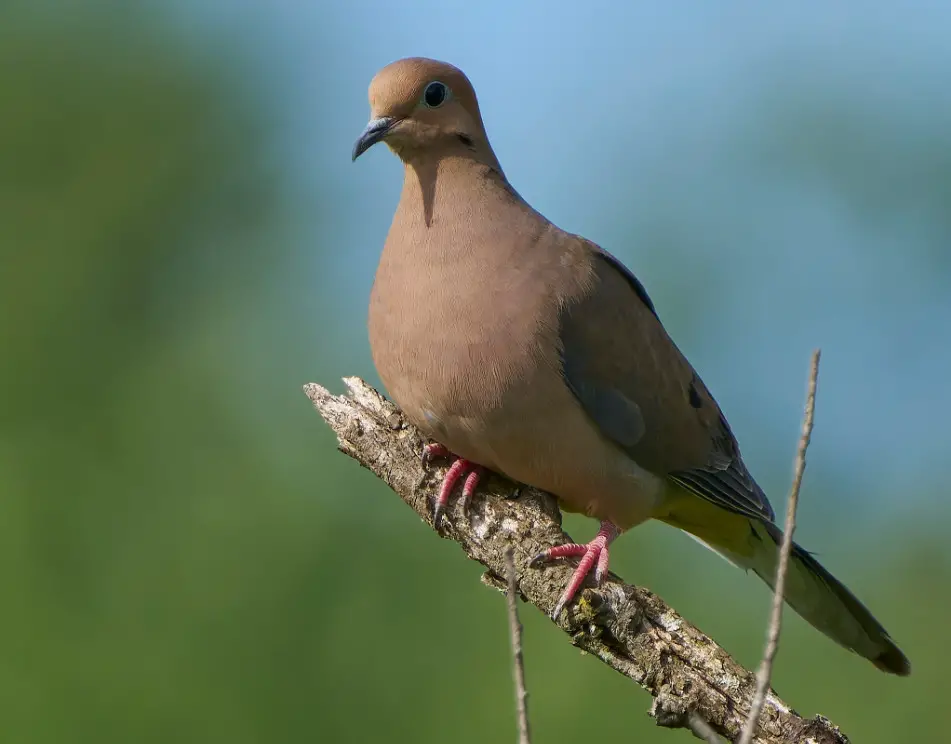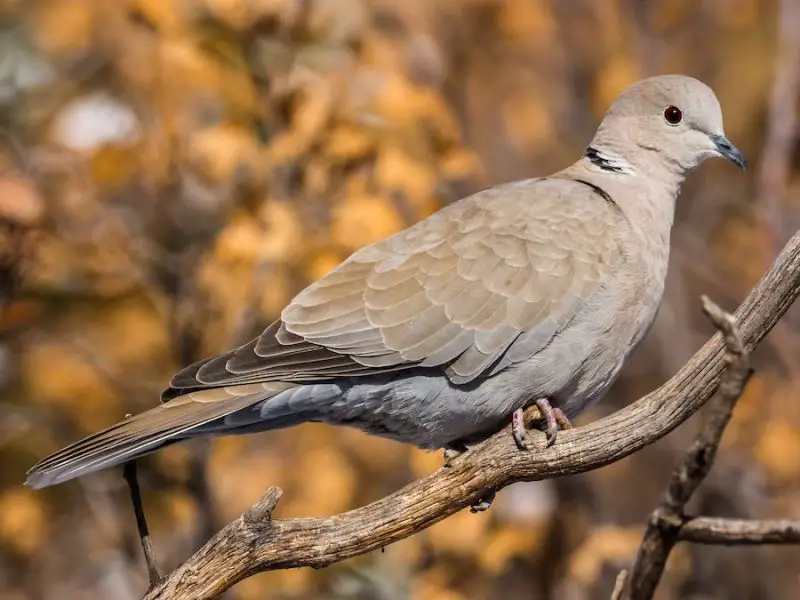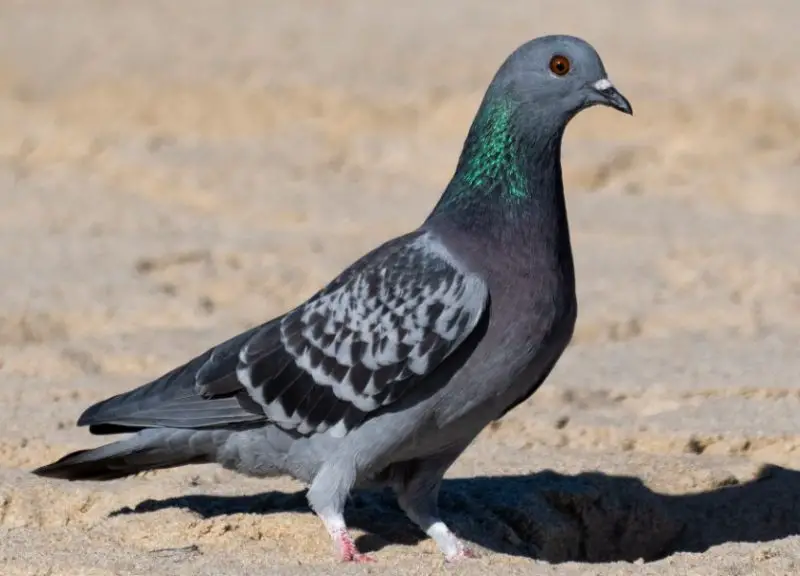Doves are gentle, graceful birds that symbolize peace and serenity. Montana, with its vast plains, open fields, and scattered woodlands, is an excellent place to observe different species of doves. These birds are often seen in both urban and rural settings, where they adapt remarkably well to human activity.
In this guide, we’ll take a detailed look at the three main types of doves in Montana. You’ll learn how to identify them, where they live, and the best times to spot them. We’ll also include a comparison table, birdwatching tips, and frequently asked questions to help you become more familiar with these birds.
Mourning Dove (Zenaida macroura)

Characteristics
The Mourning Dove is among the most abundant dove species in North America, and Montana offers an ideal environment for them. Their name comes from the soft, plaintive “coo-ah, coo, coo, coo” song, which resembles a mournful cry. Adults measure about 9–13 inches in length with a wingspan ranging from 17–18 inches, making them medium-sized doves. They weigh between 4–6 ounces, with males typically being slightly larger than females.
Plumage coloration is a blend of light brown, beige, and buff tones that provide camouflage in open landscapes. Their wings feature black spots, while the long, pointed tail is bordered with white edges that flash prominently in flight. The small, delicate head is complemented by a thin, dark bill and a subtle bluish ring around the eyes. This understated but graceful appearance makes the Mourning Dove easy to distinguish from other dove species in Montana.
Behavior
Mourning Doves are primarily seed-eating birds, with over 99% of their diet consisting of seeds and grains. They consume millet, sunflower seeds, cracked corn, and waste grain from agricultural fields. Occasionally, they supplement their diet with small insects, especially during breeding season when extra protein supports chick growth. They forage mostly on the ground, walking with a characteristic bobbing motion.
Known for their remarkable flying abilities, Mourning Doves are fast and agile, with wingbeats that produce a distinctive whistling or whinnying sound when they take off. This is thought to serve as an alarm signal to warn other doves of danger. Socially, they are often seen in pairs or small flocks, although during migration and in winter, they can gather in groups numbering in the hundreds.
Mourning Doves are monogamous, forming long-term pair bonds. Courtship involves males performing display flights and soft cooing to attract females. Once paired, the two doves work together to raise multiple broods in a season, sometimes producing up to six clutches of eggs during a single breeding cycle.
Habitat in Montana
Across Montana, Mourning Doves are highly adaptable and occupy a wide variety of landscapes. They are most common in open habitats such as grasslands, prairies, agricultural fields, and semi-open woodlands. Suburban and rural areas with bird feeders, water sources, and scattered trees also attract them.
During spring and summer, they are especially abundant near croplands, grain storage areas, and pastures where food is readily available. In more urban settings, they perch on rooftops, power lines, and fence posts, making them a familiar sight to both rural and city residents. Because of Montana’s vast stretches of farmland and open country, Mourning Doves thrive here in large numbers.
Breeding and Nesting
The Mourning Dove’s breeding season in Montana usually begins in May and extends through late August. Nest building is a joint effort, with the male collecting twigs and grasses while the female constructs the nest. These nests are often flimsy, shallow platforms placed on horizontal branches, in shrubs, or occasionally on man-made structures like window ledges and eaves.
A typical clutch contains two smooth, white eggs. Both parents share incubation duties—males often cover the nest during the day, while females take over at night. Incubation lasts around 14 days, after which the chicks hatch covered in sparse down. Both parents feed the young with a nutrient-rich secretion known as “pigeon milk,” produced in their crops. The nestlings grow quickly and fledge within 12–14 days, allowing the parents to raise multiple broods each year.
Because of their rapid reproductive cycle and high brood numbers, Mourning Doves are one of the most numerous bird species in North America. Despite heavy hunting pressure in some regions, their population remains stable due to their adaptability and high reproductive rate.
Identification Tips
To identify a Mourning Dove in Montana, watch for its slim, streamlined body and long, pointed tail that tapers to a tip with white edging. The plumage is soft brown to buff with subtle black wing spots. In flight, their rapid wingbeats and whistling wing noise set them apart from other doves.
Listen for their soft, mournful cooing, which carries across open landscapes and suburban neighborhoods. Unlike the Eurasian Collared-Dove, Mourning Doves lack a black neck ring and have a more delicate appearance. If you spot a dove perched on a fence or telephone wire with a slim silhouette and a gentle expression, it is almost certainly a Mourning Dove.
Eurasian Collared-Dove (Streptopelia decaocto)

Characteristics
The Eurasian Collared-Dove is a relatively recent arrival to North America, but it has spread with astonishing speed, including across Montana. Slightly larger than the Mourning Dove, adults typically measure between 12–14 inches in length with a wingspan of 18–22 inches. They weigh around 6 ounces, giving them a fuller, stockier build compared to their native cousins.
Plumage is generally pale gray to sandy buff, with a subtle pinkish wash on the breast that is more visible in bright sunlight. The most distinctive feature is the narrow black collar edged in white at the back of the neck, which gives the species its name. Their wings are broad and squared-off, and the tail is blunt rather than pointed. Eyes are dark with a reddish hue, surrounded by a thin pale eye-ring. In flight, their wings show broad, light gray undersides with a contrasting darker primaries.
Behavior
Eurasian Collared-Doves are highly social and often appear in small flocks, especially around food sources. Their diet is primarily composed of seeds, grains, and cereal crops, but they are opportunistic feeders and frequently take advantage of spilled birdseed beneath backyard feeders. Unlike Mourning Doves, they are more comfortable feeding directly from elevated feeders as well as on the ground.
Their call is one of the easiest ways to recognize them. It is a distinctive three-part “coo-COO-coo,” often repeated in a rhythmic pattern. This differs from the mournful, drawn-out coo of the Mourning Dove. They also produce harsh squawks and wing claps during courtship displays.
In flight, Eurasian Collared-Doves are strong fliers, with steady wingbeats and the ability to cover large distances. Their adaptability to human environments has fueled their rapid spread across North America since their introduction in the 1980s.
Habitat in Montana
In Montana, Eurasian Collared-Doves thrive in areas associated with human activity. They are particularly common in small towns, farmsteads, and suburban neighborhoods where bird feeders, grain silos, and livestock feed provide a steady food source. Unlike Mourning Doves, they rarely occupy isolated wildlands or prairies without human influence.
These doves are especially abundant in agricultural communities, where spilled grain near barns, feedlots, and storage facilities attracts large flocks. During the colder months, they remain close to human settlements, showing remarkable tolerance of Montana’s harsh winters compared to the migratory Mourning Dove.
Breeding and Nesting
The Eurasian Collared-Dove is a prolific breeder, often raising multiple broods each year in Montana. The breeding season begins as early as April and can extend into September, with some pairs nesting even longer if conditions allow. Unlike many birds that are limited to a few clutches, Collared-Doves can produce up to six broods annually.
Their nests are simple and loosely constructed platforms of twigs, straw, and grasses. These are built in a wide variety of locations, including trees, shrubs, utility poles, barn rafters, and building ledges. Females usually lay two smooth white eggs, and both parents share incubation duties for about 14 days. After hatching, the young are fed on “crop milk,” a nutrient-rich secretion produced by both adults. The chicks fledge in roughly 16–18 days, after which the pair often immediately begins another nesting cycle.
Identification Tips
Identifying a Eurasian Collared-Dove in Montana is relatively easy once you know what to look for. Their larger size, pale gray plumage, and square tail set them apart from the slimmer Mourning Dove. The black neck collar is the most definitive feature, making them unmistakable when observed closely.
Their vocalizations also provide a clear clue. If you hear a repetitive, three-part “coo-COO-coo” that carries across neighborhoods, you’re most likely listening to a Eurasian Collared-Dove. When perched, they often sit in pairs or small groups on power lines, rooftops, or trees near human dwellings, giving birdwatchers excellent opportunities for observation.
Rock Pigeon (Columba livia)

Characteristics
The Rock Pigeon, commonly called the “city pigeon,” is one of the most familiar birds in the world and a common sight in Montana. Adults typically measure between 11–14 inches in length, with wingspans of 20–26 inches, making them slightly larger and stockier than Mourning Doves and similar in size to Eurasian Collared-Doves. Their average weight ranges from 9–13 ounces, giving them a heavier build.
Although the typical Rock Pigeon has bluish-gray plumage with two black wing bars and iridescent green and purple feathers around the neck, their coloration can vary widely. Some individuals may be pure white, reddish-brown, or mottled with mixed colors due to centuries of domestication and interbreeding with escaped domestic pigeons. Their short, squared tails and robust body shape distinguish them from the slimmer, more elegant Mourning Doves.
Rock Pigeons have orange to reddish eyes with a fleshy cere (the soft skin above the beak), adding to their distinctive appearance. In flight, their broad wings beat steadily, and their flocking behavior makes them easily recognizable even at a distance.
Behavior
Unlike the quieter Mourning Dove, Rock Pigeons are bold and social, often found in large flocks that may number in the hundreds. They are comfortable around humans, frequently congregating in parks, city squares, and near grain storage facilities where food is abundant.
Their diet is diverse and highly adaptable. While seeds and grains form the bulk of their food, they readily consume fruits, bread crumbs, and other scraps provided by people. This opportunistic feeding behavior has contributed to their success in both rural and urban environments. In Montana’s agricultural areas, they are often seen near barns and grain elevators, where spilled grain provides a steady food supply.
Vocalizations are low-pitched cooing sounds, grunts, and coo-roars, less melodious than Mourning Dove calls but constant when pigeons interact in large groups. During courtship, males perform bowing displays while cooing and circling females, fanning their tails to show iridescent plumage.
Habitat in Montana
In Montana, Rock Pigeons thrive in environments where human activity provides shelter and food. They are most abundant in cities like Billings, Great Falls, and Missoula, but they are equally common in smaller towns and rural farming areas. Their close association with people means they are rarely found far from human settlements.
Unlike Mourning Doves, which prefer open fields, Rock Pigeons seek elevated nesting sites on man-made structures. Bridges, church steeples, grain silos, barns, and abandoned buildings serve as substitutes for the rocky cliffs and ledges where their wild ancestors once nested in Europe. This flexibility has enabled them to establish permanent populations throughout Montana.
Breeding and Nesting
Rock Pigeons are prolific breeders and, unlike migratory Mourning Doves, can reproduce year-round in Montana if food is available. Courtship is a noisy affair, with males strutting, cooing, and inflating their neck feathers to attract females. Once paired, the pair bond is strong, and they often stay together for life.
Their nests are simple, flat structures built of twigs, straw, and debris, often reused and added to over time until they become substantial platforms. Nest sites are typically located on ledges, attics, eaves, or rafters of barns and warehouses. Like other doves, Rock Pigeons usually lay two white eggs per clutch. Both parents incubate the eggs for about 17–19 days and feed the young with crop milk. Chicks fledge in 4–6 weeks, but unlike Mourning Doves, which quickly push their young out, pigeons may allow fledglings to remain close by, leading to large family groups.
Because they can raise multiple broods throughout the year, Rock Pigeon populations remain stable and often grow rapidly in urban areas. Their abundance has made them both a familiar bird for city dwellers and, in some cases, an agricultural nuisance.
Identification Tips
Identifying Rock Pigeons in Montana is straightforward due to their stocky shape, short tails, and tendency to gather in flocks. The typical bluish-gray plumage with two black wing bars and shimmering neck feathers is the most common form. However, birdwatchers should note their many color variations, including white, brown, or piebald individuals.
Their bold behavior also sets them apart from Mourning Doves and Eurasian Collared-Doves. While Mourning Doves are often seen alone or in pairs and Collared-Doves in small groups, Rock Pigeons regularly gather in large flocks. If you see a group of robust, grayish birds pecking on sidewalks, perched on rooftops, or circling city structures, they are almost certainly Rock Pigeons.
Comparison of Doves in Montana
Feature |
Mourning Dove |
Eurasian Collared-Dove |
Rock Pigeon |
|---|---|---|---|
Size |
Medium (9–13 in) |
Larger (12–14 in) |
Medium to large (11–14 in) |
Tail Shape |
Long, pointed |
Squared-off |
Short, fan-shaped |
Color |
Light brown/tan with black spots |
Pale gray with black neck collar |
Gray with black wing bars, iridescent neck |
Call |
Soft, mournful cooing |
Three-part “coo-COO-coo” |
Varied cooing and grunting |
Habitat |
Open fields, farms, backyards |
Towns, farms, near humans |
Cities, barns, bridges |
Native Status |
Native |
Introduced |
Introduced |
Best Time and Places to Observe Doves in Montana
Birdwatchers can enjoy observing doves throughout the year in Montana, although activity levels vary by season. Mourning Doves are most abundant in spring and summer, particularly from May to September, when they breed and feed actively. Eurasian Collared-Doves and Rock Pigeons are permanent residents and can be seen year-round.
The best places to spot doves include farmlands, grasslands, suburban neighborhoods, and urban centers. Grain fields, bird feeders, and open spaces near human settlements attract large numbers of these birds. Towns like Billings, Great Falls, and Missoula are excellent for Rock Pigeons and Collared-Doves, while rural farmlands are ideal for Mourning Doves.
For the best birdwatching experience, go out in the early morning or late afternoon, when doves are most active feeding and calling. Binoculars and a patient ear will help you recognize their unique cooing sounds.
FAQs about Doves in Montana
Are doves protected in Montana?
Yes. Mourning Doves are considered a game bird, so hunting is regulated by specific seasons and bag limits. Eurasian Collared-Doves and Rock Pigeons, being non-native, have fewer restrictions, but always check Montana’s wildlife regulations before hunting or trapping.
Can I attract doves to my backyard in Montana?
Absolutely. You can attract doves by providing seed feeders with millet, cracked corn, and sunflower seeds. Ground feeding trays also work well, as doves prefer eating on flat surfaces. Adding a birdbath will increase your chances of regular visits.
Do doves migrate in Montana?
Mourning Doves are migratory, moving south for the winter. However, Eurasian Collared-Doves and Rock Pigeons are year-round residents in Montana, adapting to the cold climate by staying near towns and farms.
How can I tell Mourning Doves apart from Eurasian Collared-Doves?
The easiest way is to check the tail and neck. Mourning Doves have long, pointed tails and no collar, while Collared-Doves have square tails and a black ring across the back of the neck. Their calls are also very different.
Why are doves important to Montana’s ecosystem?
Doves play an important role in seed dispersal, helping plants spread across the landscape. They also serve as prey for raptors such as hawks and falcons, making them a vital part of the food chain.
Conclusion
Montana is home to three main types of doves: the gentle Mourning Dove, the adaptable Eurasian Collared-Dove, and the familiar Rock Pigeon. Each species has unique characteristics, behaviors, and habitats, making birdwatching in Montana a rewarding experience.
Whether you’re walking through farmlands, exploring small towns, or simply watching from your backyard, you’re likely to encounter these birds throughout the year. By learning their identification features, calls, and habits, you can enjoy a deeper connection to Montana’s diverse birdlife.






